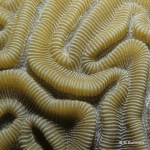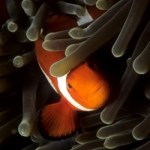Pacific
Scleractinian corals, also known as stony corals -- or just hard corals -- are the primary reef builders in the oceans. Their polyps secrete calcium carbonate to form a skeleton. A minority of species live as single polyps, but most stony coral species are colonial, and the structures they build 'grow' over time. They form a myriad of shapes: mounds, branches, fingers, plates, and encrustations.
In several previous posts I discussed and displayed photos of a number of so-called soft corals, all of which are octocorals, i.e., their polyps have eight tentacles. Stony corals are…
Many animals in the sea have evolved colors and forms that allow them to blend in with their surroundings. Some animals use their camouflage to hide from predators -- and some predators use camouflage to fool their prey.
It can be difficult to photograph such animals, partly because it's often hard to find them in the first place. If you look carefully at the photo at right, you will be able to make out the shape of a small purplish slipper lobster (Parribacus antarcticus), right in the center of the photo.
The picture was taken inside an underwater cave in Hawaii, and the lobster was on…
Many animals in the ocean seek shelter from predators by living on or among other animals. Among fishes, members of the Damselfish family (Pomacentridae) often seek protection this way. Some of these relationships also are commensal or even symbiotic.
One of the most well known symbiotic relationships in the marine world is that between anemones and fishes commonly known as 'clownfish' or 'anemonefish'. Clownfish form a subfamily, Amphiprioninae, of the Dameselfish family. Each of the twenty-some species in this subfamily lives symbiotically with one or more anemone species.
Both the…
According to a press release from the University of Washington, tropical islands may become deserts as the climate band delivering their only supply of fresh water creeps north:
The rain band near the equator that determines the supply of freshwater to nearly a billion people throughout the tropics and subtropics has been creeping north for more than 300 years, probably because of a warmer world, according to research published in the July issue of Nature Geoscience.If the band continues to migrate at just less than a mile (1.4 kilometers) a year, which is the average for all the years it…
The area collectively known as Austronesia covers half the globe. It stretches from South-East Asia and Taiwan, across New Guinea and New Zealand, to the hundreds of small islands dotted around the Pacific. Today, it is home to about 400 million people.
They are the descendants of early humans who spread throughout the Pacific in prehistoric times. These forebears are long dead but they left several unexpectedly important legacies that are evident in their modern descendants. The languages they used evolved and splintered into over 1,200 tongues spoken by modern Austronesians. The bacteria…



